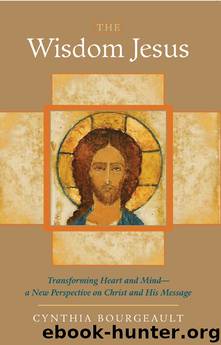The Wisdom Jesus by Cynthia Bourgeault

Author:Cynthia Bourgeault
Language: eng
Format: epub
Publisher: Shambhala
The Ultimate Kenosis
After that sending forth, the passion drama moves in earnest to the Garden at Gethsemane, to which Jesus has withdrawn for an all-night vigil of prayer. Having “talked the talk,” he must now walk the walk, confronting his own deepest fears and ambivalence in order to come to a place where, with all his own being, he can say, “Yes.”
This is the real eye of the needle. How far can you take kenosis? How far can you empty yourself? Does it stop at death? Do you draw back when finally you’re up against that threshold of your most primitive fight-or-flight instincts, or do you go through? Jesus anguishes over this, alone, in the garden. The disciples who accompanied him have fallen asleep (a telling metaphor)! Alone, he takes it on. The gospels do not diminish the fact that the struggle is an agony. Luke depicts him as literally “sweating blood.” On this of all occasions he is perhaps the most fully identified with our human fragility and mortality. Finally, out of his anguish, emerges his Yes, let it be: “Not my will but yours be done” (Luke 22:42).
It is significant that his words here are identical with those spoken by his mother Mary at the time of the annunciation: “Here I am, the servant of the Lord; let it be with me according to your word” (Luke 1:38). The Latin word for “let it be” is fiat, and in both cases the human fiat is an essential ingredient (if not the essential ingredient) enabling the mystery to unfold. This coincidence becomes even more interesting when we add to our list that third cosmic fiat in the book of Genesis: God said, “Let it be!” and the created universe comes tumbling into existence. We can begin to see that there is a tie-rod connecting “Let it be” understood as kenosis and “Let it be” understood as divine creativity. Once this point is grasped, Jesus’s fiat in the Garden of Gethsemane is not merely a capitulation to divine necessity; it is his conscious participation in “speaking” into birth the New Creation. (And once we see even further that the same is true of every fiat we are able to consciously utter in our lives, then our own kenotic path comes alive with creativity and wonder.)
When I was working on my libretto for the passion, I really wanted to emphasize the sacramental nature of this fiat, its intrinsic link with birthing new life. And this became one of those occasions I alluded to earlier where I came bolt awake in the middle of the night with a couple of biblical verses weaving themselves together in my mind. The first was Jesus’s beautiful metaphor in John 12 (just before the start of the Farewell Discourses): “Unless a grain of wheat falls into the earth and dies, it remains just a single grain; but if it dies, it bears much fruit.” The second was a line from Psalm 126: “Those who go out weeping, bearing the seeds for sowing, shall come home with shouts of joy, carrying their sheaves.
Download
This site does not store any files on its server. We only index and link to content provided by other sites. Please contact the content providers to delete copyright contents if any and email us, we'll remove relevant links or contents immediately.
| Guides | New Testament |
| Old Testament |
The Five People You Meet in Heaven by Mitch Albom(3515)
The Secret Power of Speaking God's Word by Joyce Meyer(3060)
Real Sex by Lauren F. Winner(2986)
Name Book, The: Over 10,000 Names--Their Meanings, Origins, and Spiritual Significance by Astoria Dorothy(2960)
The Holy Spirit by Billy Graham(2914)
0041152001443424520 .pdf by Unknown(2812)
How The Mind Works by Steven Pinker(2769)
ESV Study Bible by Crossway(2757)
Ancient Worlds by Michael Scott(2646)
Churchill by Paul Johnson(2540)
The Meaning of the Library by unknow(2532)
The ESV Study Bible by Crossway Bibles(2527)
The Gnostic Gospels by Pagels Elaine(2495)
MOSES THE EGYPTIAN by Jan Assmann(2393)
Jesus by Paul Johnson(2330)
City of Stairs by Robert Jackson Bennett(2326)
The Complete Dead Sea Scrolls in English (7th Edition) (Penguin Classics) by Geza Vermes(2254)
Ancient Near Eastern Thought and the Old Testament by John H. Walton(2204)
The Nativity by Geza Vermes(2202)
